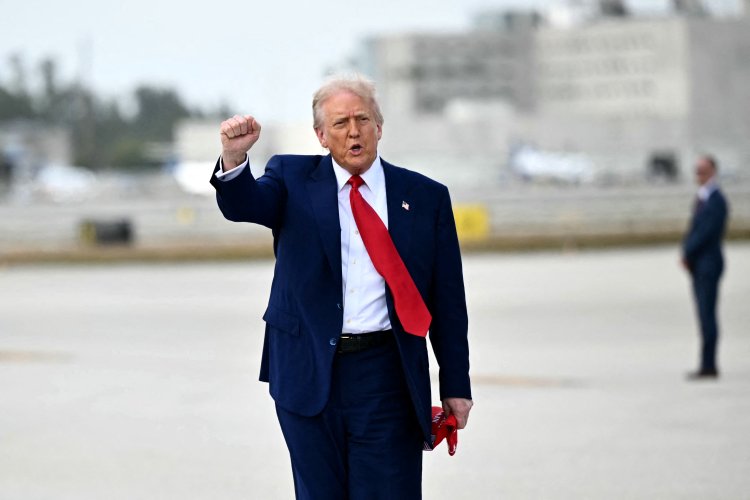Tariff Compromise: Trump Unveils Some Details on the Deal or No Deal Scenario
He’s prepared to engage in conversation, although he may not be entirely ready to make any agreements.

On Friday, Trump clarified some of the uncertainty: he is open to discussions, although he may not be ready to finalize agreements just yet.
In a post on Truth Social that morning, Trump shared that he had a conversation with Vietnam's leader To Lam about the country's proposal to eliminate all tariffs as part of an agreement with the U.S. He mentioned that he looks “forward to a meeting in the near future.” Additionally, a White House official, speaking anonymously to provide candid insights about internal discussions, confirmed that several countries have reached out to engage with the administration.
The acknowledgment that Trump is receptive to offers from other nations suggests a growing consensus both domestically and internationally that the tariffs announced during a Rose Garden ceremony on Wednesday are negotiable. However, White House officials have been careful with their wording, emphasizing that receiving offers does not equate to active negotiations.
This careful communication reflects the challenges the White House faces as even its close allies seem uncertain about Trump's intentions and are cautious about contradicting unclear signals.
Trump's recent indications signal a shift from the previous rhetoric of top administration figures, such as Commerce Secretary Howard Lutnick and chief trade advisor Peter Navarro, who insisted on Thursday that the tariffs were not merely a negotiating tool but part of a long-term strategy to revitalize domestic manufacturing and depart from an established global trade order.
A source close to the White House, granted anonymity to discuss private conversations, interpreted these earlier comments as wishful thinking from the administration's protectionist faction, arguing that they do not truly reflect Trump's motivations regarding tariffs.
“If you talk to Donald Trump, it’s about the fairness of us not getting screwed, but also using tariffs both as foreign policy and economic policy,” the source explained. “If you look at Peter Navarro, it’s, he wants to develop everything in-house. He doesn’t want to rely on China for anything. Probably pretty smart. But we’re 15 years away from having a chip industry that can supply any of our needs.”
The source disputed the emerging consensus among Republicans that the ultimate aim of these tariffs is complete free trade.
“It’s a hybrid. I don’t think it’s a full free trade thing in any way. I think if this administration could snap their fingers, I’m not saying it would be isolationist, but it would want to be self-supportive,” they added.
The source also noted that while they have not heard firm decisions regarding exemptions from high-ranking officials, they anticipate the administration may pursue sectoral-based or country-based exemptions, or possibly both.
Attempting to reconcile the protectionist messages expressed earlier in the week with Trump’s willingness to consider offers from other countries, a White House official stated that “two things can be true at the same time.”
“There’s a national emergency,” — which they argue necessitates a change in trade policy — “and countries have already reached out to talk,” the official added.
There are also legal reasons for asserting that negotiations are off the table. The White House has based its tariffs on a declared “national emergency,” claiming that unfair trade practices threaten national security, which allows them to impose tariffs without congressional approval. Suggesting that they are open to negotiation could imply the trade deficit does not constitute a true emergency, thereby undermining the legal standing of the tariffs.
A separate White House official remarked that the president is “always willing to accept phone calls from other world leaders to hear them out and to hear these proposals” but maintained that “that’s not a negotiation per se.” This official confirmed that a formal negotiation could be in the pipeline, but the administration isn't ready for that yet.
Trump’s apparent genuine interest in engaging foreign leaders comes as encouraging news for Wall Street, which had been holding out hope for productive discussions regarding tariffs. While the market experienced significant declines on Thursday, analysts noted that the drops were not as severe as they could have been if there were no expectation of negotiation.
Despite the White House’s commitment before April 2 to provide clarity about the tariffs, the outcome has been far from straightforward. Trump’s willingness to entertain offers from other countries does not necessarily imply that he is prepared to act on reducing the tariffs anytime soon.
"The fact that there was a debate about what to do with the tariffs up until basically the last minute and now that there is debate about whether there are going to be deals or not, has really brought home to the business community that there does not appear to be any clear plan with the tariffs," noted Peter Harrell, who headed the international economics team on President Joe Biden’s National Security Council.
Trump not only set tariffs higher than many businesses anticipated; he also enforced both a global tariff and increased reciprocal tariffs, potentially disrupting companies' strategies made seven years ago when they began relocating production from China to countries like Mexico and Vietnam, which currently have lower tariffs and better diplomatic relations with the U.S.
As the market reacts to the likelihood of retaliation from major trading partners and Trump’s openness to negotiations, businesses are evaluating their engagement with the administration on a case-by-case basis regarding tariffs. For example, the auto industry is currently focused on easing Trump’s initial tariffs on Canada and Mexico while putting discussions about the broader global tariffs on hold. They fully expect that Trump's 25 percent tariff on automobiles, which took effect on Wednesday, will remain for the entirety of his term.
Nevertheless, some nations are still hopeful about reaching deals. Mexican Economy Minister Marcelo Ebrard expressed on Thursday night that Mexico aims to finalize an agreement with the Trump administration in the coming days to address concerns related to auto tariffs, as well as the recently imposed tariffs on steel and aluminum.
“We need to reduce as most as we can, as far as we can, uncertainties and reduce tariffs on cars and steel and aluminum. This is the work to do the next four days,” Ebrard mentioned during a virtual discussion hosted by the Council of Americas, a business group focused on the Western Hemisphere.
He also indicated that he felt “more optimistic” about the future of the U.S.-Mexico-Canada Agreement (USMCA), the trade deal negotiated by Trump during his first term, compared to his outlook from two weeks prior.
Next year, the three countries are set to review the USMCA, but this is anticipated to evolve into broader trade negotiations that may start in the coming weeks. U.S. Trade Representative Jamieson Greer, in an interview on Thursday with Fox Business Network, stated that the administration has a variety of ideas for those discussions.
“We're already thinking of all the ways we need to tighten up that deal in a big way, to make sure that third countries aren't benefiting from it, make sure we're incentivizing American production, and to make sure that Canada and Mexico live up to their commitments with respect to market access,” Greer said.
Frederick R Cook for TROIB News
Find more stories on Business, Economy and Finance in TROIB business












